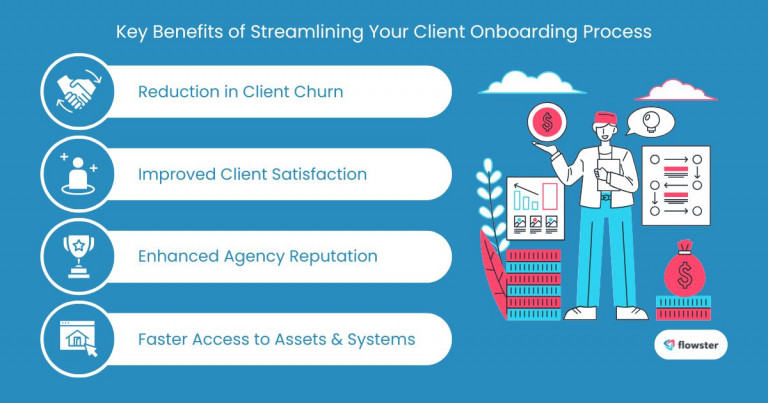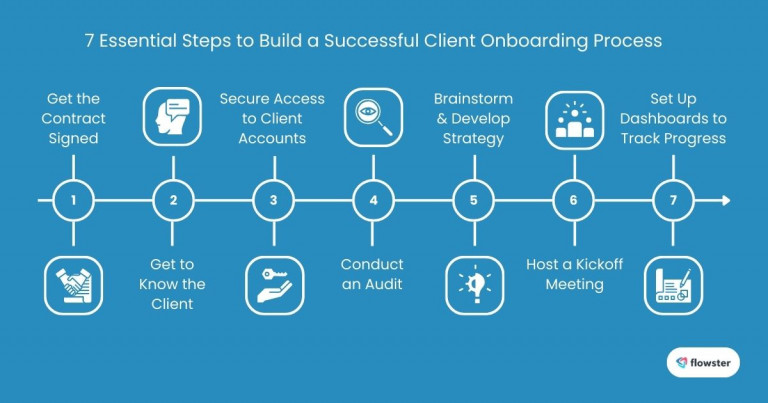A smooth client onboarding process is crucial for agencies to establish strong and lasting relationships with their clients. Effective onboarding not only helps reduce client churn but also fosters trust and sets the stage for long-term business collaborations. By providing a seamless and positive initial experience, agencies can increase client satisfaction and retention rates.
In this guide, we’ll delve into the essential steps to create efficient and effective client onboarding workflows that will help your agency thrive. We’ll cover topics such as pre-boarding communication, welcome packets, project kickoff meetings, and ongoing support. By implementing these strategies, you can ensure a smooth transition for your clients and set the foundation for successful partnerships.
Article Outline
What Is Client Onboarding and Why It Matters?
Client onboarding is the process of welcoming new clients to your agency and ensuring a smooth transition from initial contact to project initiation. It’s a critical step in building strong and lasting relationships with your clients.
By effectively onboarding new clients, you can:
- Set clear expectations: Communicate your agency’s processes, deliverables, and timelines to avoid misunderstandings and ensure everyone is aligned from the start.
- Build trust: Demonstrate professionalism, reliability, and a commitment to providing exceptional service.
- Ensure a smooth workflow: Establish effective communication channels and collaboration processes to facilitate efficient project execution.
A study highlighted that agencies with streamlined onboarding processes experienced a 20% reduction in client churn and a 30% increase in client satisfaction. This underscores the significance of investing in effective client onboarding strategies to cultivate long-term relationships and enhance business growth.

Key Benefits of Streamlining Your Client Onboarding Process
A well-structured and efficient client onboarding workflow offers numerous advantages for your agency. Here are some of the key benefits:
- Reduction in client churn: A smooth onboarding experience helps to set expectations, build trust, and ensure client satisfaction. By addressing any potential issues or concerns early on, you can reduce the likelihood of clients terminating their contracts. This not only saves your agency time and resources but also prevents lost revenue.
- Improved client satisfaction: A positive onboarding experience fosters a strong relationship between your agency and your clients. Satisfied clients are more likely to recommend your services to others, leading to increased referrals and business growth.
- Enhanced agency reputation: A reputation for providing excellent client service can be a powerful asset for your agency. Positive word-of-mouth referrals can help attract new clients and solidify your position in the market.
- Faster access to necessary assets and systems: A streamlined onboarding process ensures that clients have timely access to the tools and resources they need to collaborate effectively. This enables projects to get off to a quicker start, leading to increased productivity and efficiency.
By streamlining your client onboarding process, you can reap these benefits and create a positive and productive experience for both your agency and your clients.
Flowster's AI-Driven Automation
7 Essential Steps to Build a Successful Client Onboarding Process
A well-structured client onboarding workflow is essential for creating a seamless and positive experience for your new clients. By following these seven steps, you can ensure a smooth transition and set the stage for a successful partnership.
Step 1: Get the Contract Signed
Formalizing the relationship with a signed contract is crucial to establish clear expectations and protect your agency’s interests. The contract should outline the scope of work, deliverables, timelines, payment terms, and other relevant details.
Step 2: Get to Know the Client
Understanding your client’s goals, pain points, and business objectives is essential for tailoring your services to their specific needs. Conduct an initial meeting or use questionnaires to gather insights and build a strong foundation for the relationship.
Step 3: Secure Access to Client Accounts
To effectively manage your client’s accounts and implement strategies, you’ll need access to their various platforms and tools. Discuss the necessary accounts (e.g., social media, CRM, analytics) and provide clear instructions for granting access. Consider using tools like Leadsie to streamline this process.
Step 4: Conduct an Audit
Assessing your client’s current marketing situation, including their channels, website traffic, and performance metrics, is essential for identifying strengths, weaknesses, and opportunities. This audit will help you develop a more effective strategy.
Step 5: Brainstorm and Develop Strategy
Collaborate with your team to brainstorm ideas and develop a tailored strategy that addresses your client’s specific needs and goals. Ensure that everyone on the team is aligned on objectives and priorities.
Step 6: Host a Kickoff Meeting
A kickoff meeting is an excellent opportunity to introduce your team, present the strategy, and define key milestones. Ensure clear communication and alignment on deliverables and KPIs to set the project on the right track.
Step 7: Set Up Dashboards to Track Progress
Establish client-facing dashboards to track key performance indicators (KPIs) and project progress. This transparency will help build trust and ensure that both parties are aligned on goals and outcomes. Consider using tools like Google Data Studio or spreadsheets for reporting.
By following these steps, you can create a streamlined and effective client onboarding workflow that will help your agency build strong relationships and deliver exceptional results.

Common Challenges in Client Onboarding Processes and How to Overcome Them
Even with a well-structured client onboarding workflow, agencies may encounter common challenges that can hinder the process. Here are some of the most frequent issues and strategies to overcome them:
Access to Client Accounts
Gaining timely access to client accounts can be a roadblock in the onboarding process. To address this, consider implementing automation tools that simplify the process. These tools can streamline account requests and permissions, saving time and reducing administrative burdens.
Setting Clear Expectations
Miscommunication and misunderstandings can arise if expectations are not clearly defined from the outset. To avoid these issues, create detailed onboarding documents that outline the process, timelines, deliverables, and communication channels. Regular communication and check-ins can also help ensure everyone is on the same page.
Keeping Onboarding Consistent Without Overwhelming the Client
A lengthy or overly complex onboarding process can overwhelm clients and create a negative impression. To strike a balance, streamline the process by prioritizing essential steps and providing clear instructions. Break down the onboarding process into manageable stages and offer ongoing support to guide clients through each step.
By addressing these common challenges and implementing effective strategies, agencies can create a smoother and more efficient client onboarding experience, fostering stronger relationships and setting the stage for successful partnerships.
Capture Your Processes in Minutes!
Use This Free Template to Create Client Onboarding Workflows
To streamline your client onboarding workflows and ensure a consistent, efficient process, consider using this free template from Flowster: Marketing Agency Client Onboarding. This customizable template provides a structured framework for guiding your clients through the onboarding process.
Key benefits of using this template include:
- Clear and concise workflow: The template outlines the essential steps involved in onboarding new clients, ensuring a consistent and efficient process.
- Customization: You can easily customize the template to fit your agency’s specific needs and processes.
- Improved efficiency: By using a standardized template, you can reduce the time and effort required for onboarding new clients.
By leveraging this free template, you can create effective client onboarding workflows that enhance client satisfaction, reduce churn, and set the stage for successful long-term partnerships.
Marketing Agency Client Onboarding
Click anywhere in the template to start creating your client onboarding workflow.
Get More Leads, Accelerate Growth, and Delegate More Work
Sign up to download our FREE Business Growth Accelerator Bundle. Here are the workflows you get:
- Cold Email Outreach: Fill your calendar with qualified sales appointments every week.
- Content Marketing: Ensure every blog post is perfectly written, optimized, and promoted.
- YouTube Videos: Ensure every video is perfectly planned, published, and promoted.
- Search Engine Optimization: Grow your organic traffic using Ahrefs powerful SEO software.
- Facebook Ads: Create and optimize your Facebook campaigns the right way.
Conclusion: Build Stronger Relationships with an Effective Client Onboarding Process
A well-structured client onboarding workflow is essential for building strong, lasting relationships with your clients. By providing a seamless and positive initial experience, you can increase client satisfaction, reduce churn, and set the stage for long-term success.
The first 90 days of a client relationship are crucial for establishing trust and setting expectations. By investing in an effective onboarding process, you can ensure a smooth transition and lay the foundation for a successful partnership.
To optimize your client onboarding workflows and improve your agency’s overall success, take action today. Implement the strategies outlined in this guide and consider using free templates from Flowster Marketplace to streamline your processes.
By prioritizing client onboarding, you can build stronger relationships, drive business growth, and position your agency for long-term success.




